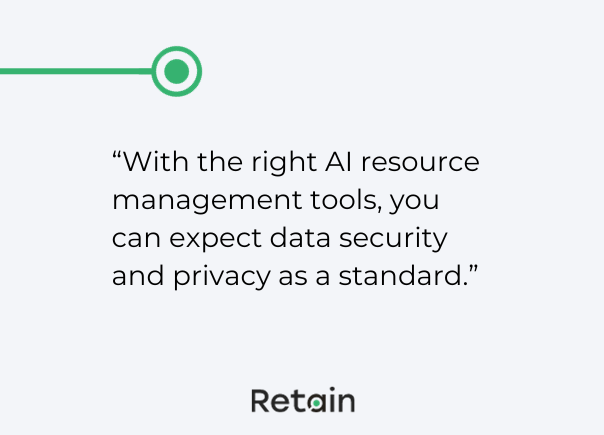AI is adding a new layer of precision to the way businesses manage resources. But with great power comes great responsibility, especially when it comes to security and privacy. For specialist businesses like yours—where client confidentiality is key—leveraging AI demands a commitment to privacy right from the get-go.
With this in mind, we’ve focused this blog specifically on the best practices to maintain security and privacy in AI resource management.
Why AI is transforming resource management
Before we go into AI in resource management data privacy and security best practices, it’s worth covering why AI is in the spotlight. Essentially, businesses that leverage AI for resource management see:
🟢Improved efficiency and productivity: AI automates routine tasks, allowing staff to focus on more complex and value-added activities.
🟢Reflex decision-making: AI rapidly analyses vast amounts of data to provide instant insights and forecasts for more accurate and strategic decision-making.
🟢Cost savings: Optimising resource management and reducing manual effort helps lower operational costs.
🟢Real-time insights: AI can support the prediction of future resource needs based on trends and historical data for more forward-thinking planning.
🟢Greater flexibility: AI systems can quickly adapt to changes so that businesses to respond rapidly to changes in demands and market conditions.
🟢Better client experiences: With AI handling routine tasks, businesses make better resourcing decisions so that the right specialists are allocated and projects hit deadlines.
Sounds intriguing? Of course, it does. But you might have concerns with AI, like whether you can verify decisions for full audit trails. So let’s take a look at the so-called ‘black box’ issue and how you can overcome it.
What about AI’s ‘black box’ issue?

AI holds incredible promise, but the “black box” issue rightfully raises eyebrows, especially for professional services. How can firms stand behind decisions they aren’t fully confident in?
What is the black box issue?
Resource management software increasingly uses complicated AI and algorithms to optimise efficiency. However, the "black box" metaphor conveys how these systems’ inner workings can remain opaque.
While inputs and outputs can be observed, how and why the software allocates resources in a certain way may be unclear. This lack of transparency makes it difficult to trust and oversee these AI systems.
Opening up these "black boxes" is key for ethical and reliable integration—and for full audit trails.
That’s why Retain provides clarity on how the suitability match is made—for example, is it previous engagements with the client, experience in similar roles, or specific transferable skills? This level of transparency not only helps you fine-tune your search criteria but also reassures all stakeholders that the results are fair, impartial, and perfectly in tune with client requirements.
With Retain, you’re not just managing resources, you’re doing it with full transparency.
Now that’s cleared up, let's look at what you need to benefit from AI for resource management—whilst also protecting clients and your business. ?
7 steps to enhancing security and privacy in AI resource management
As businesses adopt AI for resource management, one of the biggest focuses should be on maintaining data security. Here's a closer look at the leading techniques and best practices that form the backbone of security and privacy in AI resource management:
#1: Data encryption
Encrypting data is crucial. This step is fundamental in preventing unauthorised access to sensitive information.
#2: Access control
Putting in place stringent access controls—with granular permission policies—is a must-have. This ensures that only essential personnel have access to critical data to cover all bases and reduce the risk of internal threats.
#3: Network-level security
Using VPNs, firewalls, and network segmentation forms a protective barrier. These tools help to isolate AI systems and enable close monitoring of activities.
#4: Secure coding practices
If you’re building AI models in-house, during development you’ll need to introduce practices like input validation and threat modeling.
#5: Vulnerability testing
Before deploying any AI systems, you’ll need to test-run using them in the business. Using a small department can help test for any vulnerabilities and mitigate any potential threats—safeguarding you before you roll it out to the rest of the business.
#6: Continuous monitoring and auditing
After AI is deployed, it doesn’t end there. You must monitor AI systems continuously and create audit trails. This helps in tracking access and identifying unusual activities.
#7: Regular updates
And, of course, regularly updating systems to take on the latest data protection laws and tech advancements keep you ahead of hackers and new forms of cyber attack.
To sum up: Think about security from the start of planning all the way through to actually using AI. These steps act as a strong barrier, guarding against dangers from outside and inside the company—making sure AI processes are not only effective but also safe.
Now, we’ve covered some of the basics of security and privacy in AI resource management. Let’s now look at practices followed by market-leading businesses.
Security and privacy in AI resource management best practices
Now, the key to maintaining security and privacy is being proactive. The challenge is, all of the above is rather a tall order. And that’s where tech comes in. With resource management software powered by AI, this all becomes much easier to handle. Here’s why…
With the right AI resource management software, you can expect data security and privacy as a standard. The tech is specifically built with features like these to make life easier:
✅ Data encryption: Ensuring that all client information is securely encoded and inaccessible to unauthorised users.
✅ Data use validation: The visibility into an AI system's data usage assures clients that sensitive information is only leveraged in appropriate and relevant ways. This validation encourages ongoing data sharing.
✅ A right match: On top of protecting clients, the right tech provides clarity on how suitable specialists are matched with client projects – like is it previous engagement with the client, or experience in similar roles. This reassures them that results are fair, impartial and perfectly in tune with their needs.
✅ Access controls: Features like multi-factor authentication and role-based permission settings ensure only authorised personnel can access sensitive data. This limits entry points for attackers.
✅ Automated regulatory compliance: Professional services firms often undergo compliance audits. The right tech can explain the rationale behind suggestions and help provide auditable verification that decisions are sound and accountable.
✅ Threat detection: AI algorithms can monitor networks for unusual activities, identifying potential threats in real time. This early detection is key to closing vulnerabilities before attackers can exploit them.
✅ One central platform: Plus, these solutions provide businesses with a centralised view of their data handling practices—making it much easier to manage privacy policies and user consents.
Ultimately, the best resource management tools tend to be cloud-based which means, as a bare minimum, you can expect regular security updates, advanced threat detection systems, and high-level encryption—all making it easier for businesses to manage data security.

Balancing security and privacy with AI-powered efficiency
As AI drives innovation in resource management, balancing its efficiency-boosting capabilities with ethical data safeguards is essential to protect both your business and your clients. Explainable decisions, encryption, access controls and more protect client assets and trust. But continual learning and adapting to emerging threats are equally key to ensure AI systems remain effective, yet private.
Key takeaway: To maintain trust, these ultra-smart resource management systems must be built just as much for ethical data handling as predictive power.
That’s why Retain’s AI features are built to comply with strict security measures. They protect your sensitive information and guarantee compliance with industry standards and regulations. With Retain, it’s not just about getting the job done, it’s about doing it securely and privately.
Your next steps. If you’re actively looking for a system to ensure security and privacy in AI resource management, look no further. Retain lets you leverage AI to manage resources—but with full transparency.


